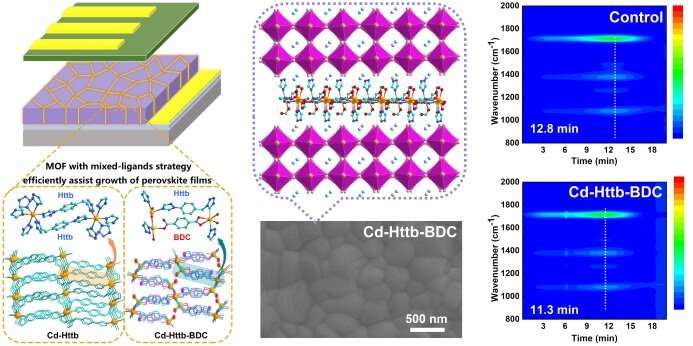A strategy to assist crystallization for efficient and stable perovskite solar cells

Recent developments have enabled perovskite solar cells (PSCs) to achieve power conversion efficiencies exceeding 25.7%; thus, these devices are considered rising stars in the photovoltaics field. However, the homogeneous crystallization of perovskite may lead to disordered crystalline orientations and defects in the bulk phase and grain boundaries, thereby restricting the performance and stability of PSCs. Defect passivation and crystallization regulation are considered effective strategies to improve the performance of these devices.
Metal-organic framework (MOF) materials play an important role in regulating perovskite crystallization and passivation defects and improving carrier mobility owing to their highly porous structures, strong functional structure design, and other advantages. However, current research indicates that most MOFs applied to PSCs lack the functional design of their structures. In this case, a mixed-ligands strategy can not only design functional MOFs with novel structures but also passivate defects and regulate perovskite crystallization via the synergistic effect of the selected ligands.
Assistant researcher Yayu Dong, professors Yulin Yang and Ruiqing Fan, associate professor Jian Zhang, and others of Harbin Institute of Technology recently published a manuscript, titled "Metal-Organic Frameworks with Mixed-Ligands Strategy as Heterogeneous Nucleation Center to Assist Crystallization for Efficient and Stable Perovskite Solar Cells," in the Journal of Energy Chemistry.
The flexible organic ligand 5-(4-(1H-1,2,4-triazole-1-yl)benzyl)-1H-tetrazole (Httb) was selected to construct a novel 3D MOF (Cd-Httb). A second ligand, 1,4-dicarboxybenzene (H2BDC), was then introduced to this MOF to successfully construct another novel 3D MOF (Cd-Httb-BDC).
Compared with the control and Cd-Httb, Cd-Httb-BDC designed with mixed ligands served as a nanostructured heterogeneous nucleation seed and effectively assisted the crystallization of high-quality large-grain perovskite films. It also reduced the density of defect states, thereby improving the efficiency and stability of PSCs.
This work provides a theoretical basis for synthesizing novel functionalized MOFs to prepare PSCs, which is of great significance for the commercialization of perovskite-based photovoltaic devices.
More information: Yayu Dong et al, Metal-organic frameworks with mixed-ligands strategy as heterogeneous nucleation center to assist crystallization for efficient and stable perovskite solar cells, Journal of Energy Chemistry (2022). DOI: 10.1016/j.jechem.2022.10.029


















